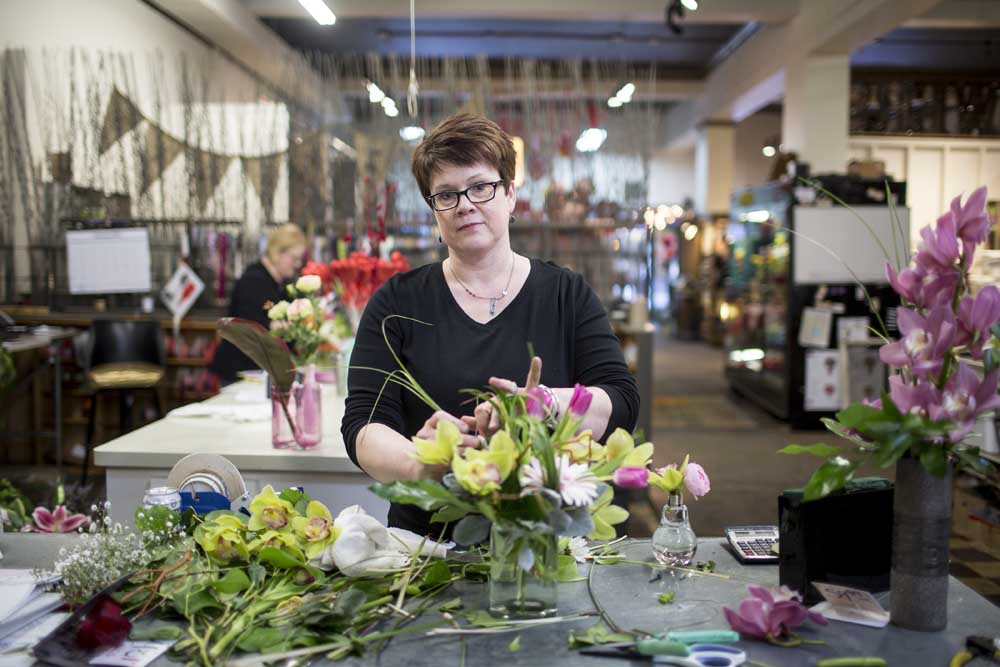Changing the florist model
Published 12:00 am Friday, February 12, 2016

- Jenn Ackerman / The New York TimesRhoda Paurus, owner of St. Cloud Floral, who recently switched her websiteís e-commerce system from Telefloraís to one run by BloomNation, in St. Cloud, Minnesota. National merchants like 1-800-Flowers and FTD.com can take more than 25 percent of a sale from local florists, but several startups like BloomNation, that bills itself as an Etsy for flowers, are challenging that model.
This weekend, florists across the country will send out millions of Valentine’s Day bouquets filled with roses, carnations, tulips and other blooming symbols of love. And some will lose money on almost every single sale.
The neighborhood flower store, once a retail staple, is rapidly disappearing. Nearly 40 percent of America’s floral businesses have closed since 2000, with 14,000 remaining at last count, in 2013, according to census data. The number of paid employees in the field has been cut in half. A recent market report from IBISWorld put it bluntly: “The florists industry has entered the declining stage of its life cycle.”
Trending
The recession and shoppers’ changing preferences have played a role: Fresh flowers are a luxury that tend to get scrapped when money is tight. But florists say one of their biggest challenges is a behind-the-scenes margin fight that plays out every time a buyer goes online to arrange a flower delivery.
If a shopper goes directly to a florist’s website, the store keeps most of the revenue from the sale. That calculation changes radically if buyers go through national merchants like 1-800-Flowers and FTD.com, or if they search for local sellers on Google and click the resulting ads, which are often placed by virtual companies with no inventory of their own. In all of those cases, a big chunk of the transaction is captured by middlemen.
That leaves the brick-and-mortar merchants, to whom the orders are passed for fulfillment, typically collecting 70 percent or less of the sale price, fueling a sort of love-hate relationship with online merchants. While they can increase business for a florist, that business can come at a high price.
“It’s break-even at best on the vast majority,” Bonnie Bank, the controller of Superior Florist, an 86-year-old flower shop in Manhattan, said of the orders placed with her shop by outside sellers. “The higher-dollar ones, maybe you can make a small margin.”
The dilemma has also created an opening for new entrants into the online market — like BloomNation, a startup in Santa Monica, California, that bills itself as an Etsy for flowers, and GotFlowers, created by a software developer who is also based in California.
The industry’s current financial structure has its roots in a century-old practice. In 1910, a group of 15 American florists formed a cooperative, the Florists’ Telegraph Delivery service, to exchange orders. A customer in Denver would, for example, be able to walk into a local flower shop and arrange a delivery to a friend in Boston. The originating florist transmitted the order through the florists’ wire service and received a commission for the effort; the rest of the money was passed on to the fulfilling merchant.
Trending
Two changes upended that genteel arrangement. First, technology made it easier for customers to shop with national retailers offering a standardized product catalog, a trend the Internet rapidly accelerated. And around the same time, the wire services began competing more directly with their merchants to capture incoming sales. In 1994, the members of FTD, which had by then been renamed Florists’ Transworld Delivery, privatized their co-op and sold it to an investment fund for $150 million.
In a typical wire service transaction today, the originating merchant receives 20 percent of the sale price, and the wire service — FTD, 1-800-Flowers and Teleflora are the industry’s big three — keeps 7 percent. If an order comes in directly through a wire’s website, the service keeps the full 27 percent.
Irked by misleading orders and the wire services’ fees, Rhoda Paurus, the owner of St. Cloud Floral in Minnesota, is considering dropping both of her services, FTD and Teleflora. She took the first step toward separation in May, when she switched her website’s e-commerce system from Teleflora’s to one run by BloomNation.
BloomNation charges a flat 10 percent fee on the orders it processes, and it does not have a standardized product catalog. Merchants take and post photos of their own arrangements.
That part particularly delights Paurus, who changes her photos daily.
“If we get a double shipment of roses, within a few minutes, we can have a rose special on our website,” she said.








